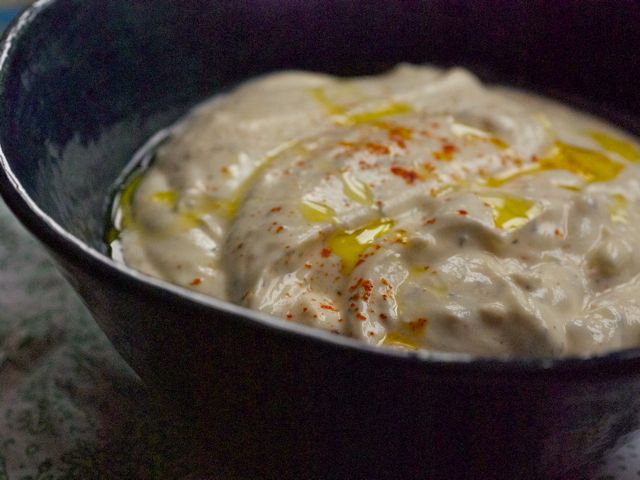
reference-image, l
(article, Deborah Madison)
[%pageBreakSettings nobreak=true] Years ago, I arrived starving. I had gone to visit my friend, the cook and historian Clifford Wright, and I was ravenous when I got to his place. I knew I had to eat a little something, even though the hour was not an eating hour; it was 4 o'clock, and a wonderful dinner would be coming soon. [%image reference-image float=right width=400 caption="Cliff's Yogurt Sauce."] But Cliff, who is a world traveler, understood that travel takes its toll on appetites and their timing, so with no fuss at all, he served up a dish of lentils and set it down before me, along with a bowl of yogurt sauce. I spooned the yogurt into the lentils, inhaled, then dove in. At that moment, those lentils and that yogurt were the most delicious foods I had ever eaten. While hunger does sharpen the appetite — sometimes to an untrustworthy degree — the goodness of this food extended far beyond the moment. For example, typing this in my hot little office and recalling that meal, I can easily conjure a desire for a bowl of lentils with Cliff's yogurt sauce. I already have the yogurt sauce, in fact. I just need to cook some lentils, and maybe a little chard, too. There’s a ripe tomato to pick and slice. I already know this will be dinner. I can already taste it. It’s early in the day, and I can’t wait. [[block(sidebar). h1.Featured recipe]] But back to the sauce, because this is the part of this two-dish interlude supper I took away. It’s not complicated, so you might be wondering, why bring it up? I bring it up because it is delicious on just about everything. Imagine a bowl of rich yogurt made richer by the inclusion of labna, strained yogurt that’s something like Greek yogurt, then seasoned with crushed garlic, fresh dill, and cayenne. Simple. Of course, Cliff wouldn’t just put it on the table like that. Instead, he swirled olive oil in a spiral over the surface, then dusted it with more cayenne, so it was beautiful, too. And that’s all there is to it. Cliff’s Yogurt Sauce, as I think of it, has become firmly stitched into my culinary life. I don’t always have it around, but when I make it, I make a lot, and then spoon it over pretty much everything for the next week. It has pizzazz and enhances whatever it comes into contact with. Like what? you ask. Those lentils, for example: warm, the sauce melting into them and adding its garlic and dill breath. I might scatter over some toasted breadcrumbs. I might add more liquid and turn the lentils into a soup, or I might make a salad of them with diced cucumbers and sliced garden tomatoes. But regardless, Cliff’s Yogurt Sauce will be there. Chickpeas are ever so much more delicious served this way, especially if you've cooked your own. And while we’re on legumes, what about ful? Why not pinto beans? The sauce will work with pretty much any kind of bean. I happen to like Cliff’s Yogurt Sauce spooned over everything that’s in the farmers' market right now: sautéed greens, snaky cucumbers, steamed golden beets, beefsteak tomatoes, grilled eggplant, slow-cooked zucchini with herbs, green beans. Potatoes from my garden. In a month or so, the sauce will be spooned over grilled or sautéed winter squash. I wouldn’t hesitate to drizzle it into a pita sandwich. I spoon it over grilled fish. I’ll swirl some into a roasted-pepper soup or a spicy dish of scrambled eggs. Cliff says he likes it as a dip for köfte (little ovals of grilled lamb), and since my neighbor and good friend raises sheep, köfte show up at my house too — with the sauce, of course. Cliff’s Yogurt Sauce does wonders for grains, like the frikeh from Ayers Creek Farm, or the cracked wheat, rice, or couscous that you cooked to go with a late-summer vegetable stew. Cliff suggests that you serve it with good French bread and scallions. I like it with whole-wheat naan, warmed on the grill, or even whole-wheat tortillas (which are no longer tortillas once they get all good and grainy). I have not gone so far as to put it on fruit, however. Cliff’s sauce is from Turkey, where it is called açili esme. The recipe is in his big book, A Mediterranean Feast. Full of culinary treasures and history, this important book should be in any food person’s library. (I might add that Cliff is about the best cook I know, so you’ll go far with its 500-plus recipes.) Two notes about the recipe: It calls for four cloves of garlic, but I use two. And Cliff doesn’t say to do it, but I sprinkle extra cayenne over the surface. If the dill has gone to seed, I add a few dill seeds as well, because they look so dramatic. p(bio). Deborah Madison is the author of numerous award-winning cookbooks, including Local Flavors. She lives in New Mexico.

reference-image, l